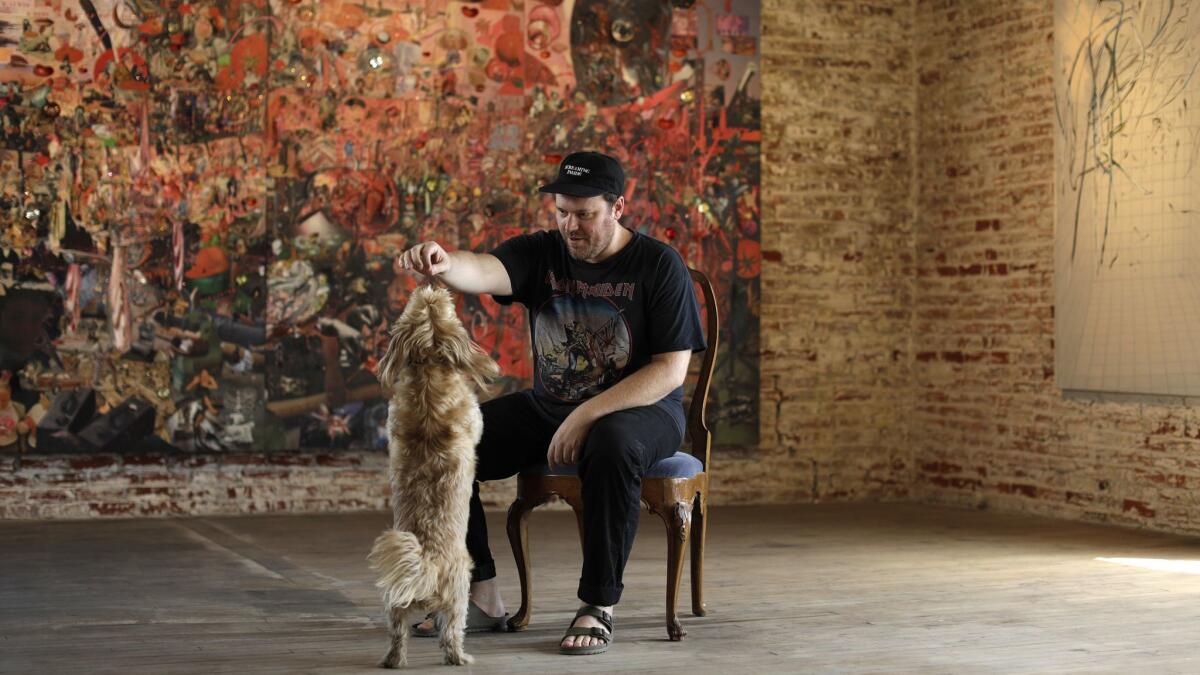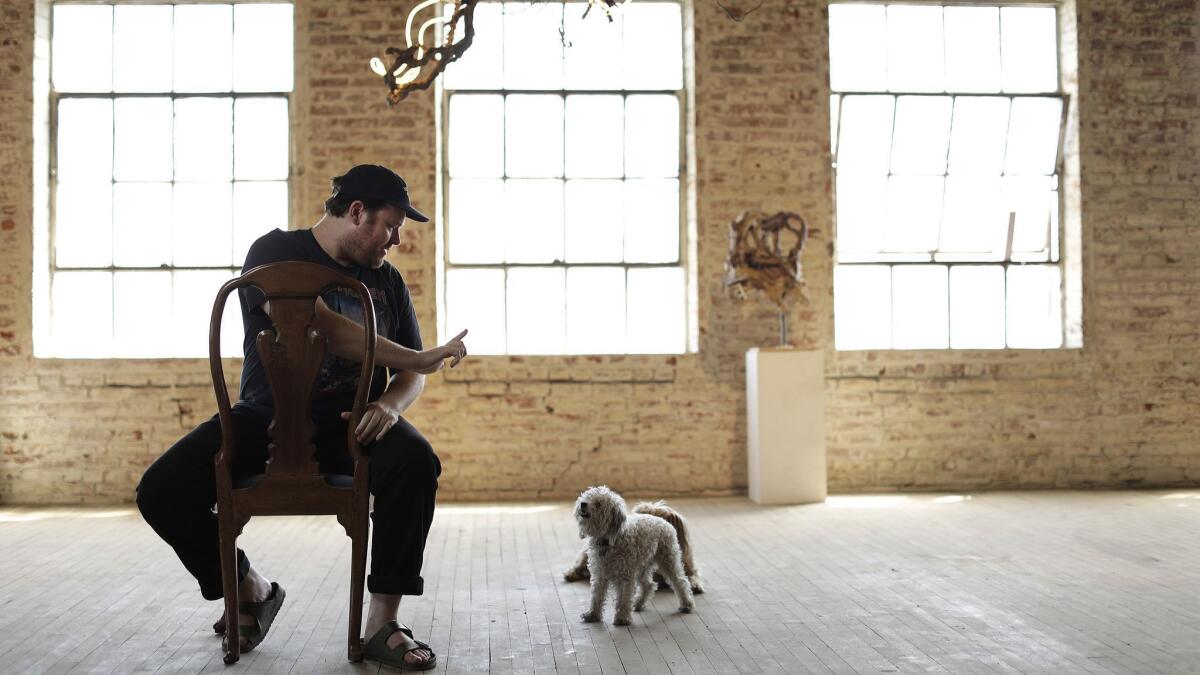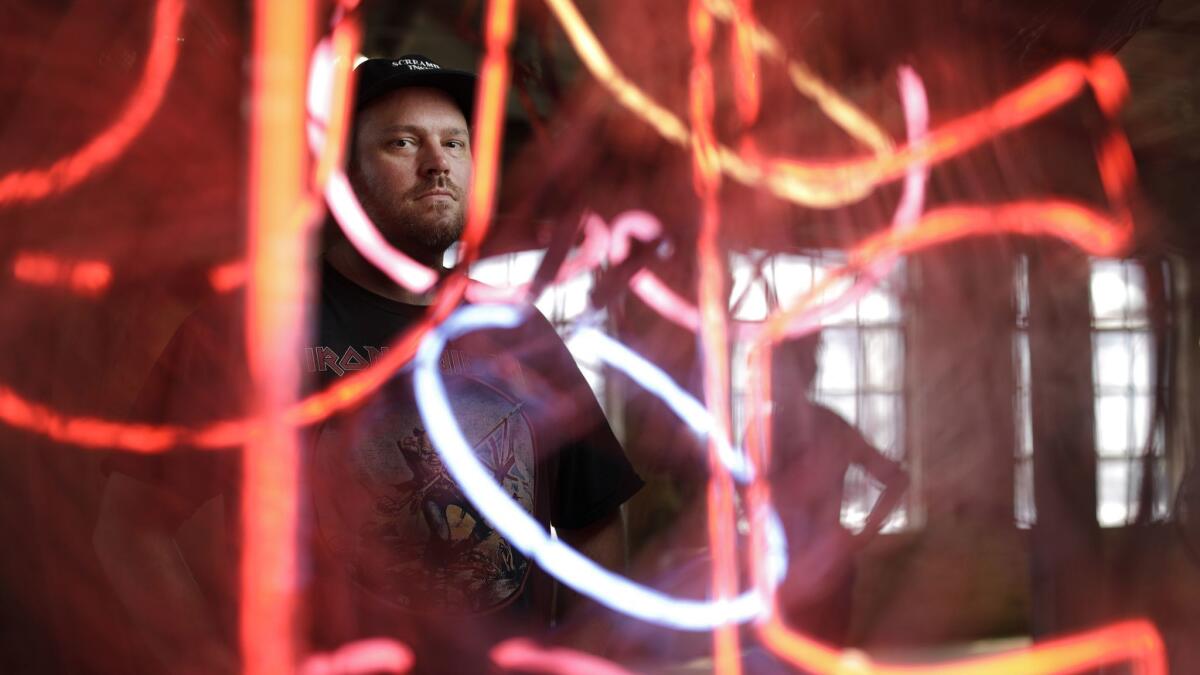Elliott Hundley’s painting at the Broad puts ancient history under a modern magnifying glass
Time is fluid and malleable in Elliott Hundley’s three dimensional, mixed-media painting “the high house low!” (2011), an explosion of color and texture that sucks the viewer into a visual drama sparking with fire and rage.
The four-panel assemblage work measuring more than 16 feet wide — a vortex of collaged and pinned cutouts from photographs and letters along with mounted jewelry wire, decorative fans, sequins, bits of fabric and other found objects — has gone on view at the Broad museum. It’s part of the exhibition “A Journey That Wasn’t,” a reinstallation of the permanent collection that explores the passage of time.
The show’s 55 paintings, photographs, sculptures, films and installations are by 21 artists. They address memory and perception, aging and evolving identity, history, creativity and art appropriation, among other themes. Hundley’s work, an ode to Euripides’ 400 BC Greek tragedy “The Bacchae,” fuses all those ideas and more.
Each panel depicts the same passage from the play but different translations of it from 1959, 1968, 1998 and 2008. A giant, sliding magnifying glass hovering over the canvas allows viewers to peer into Hundley’s dense worlds, which are teeming with itty bitty objects conveying big ideas.
The Los Angeles artist cites Robert Rauschenberg, Jean-Michel Basquiat, Richard Tuttle and Cy Twombly as inspirations along with the poet Anne Carson and the late San Francisco artist Jess Collins.
Hundley has been working in large-scale assemblage for more than a decade. It’s a format that’s purposefully transformable, he said in this edited conversation.
“The implication is you can rearrange the piece by taking the pins out and putting them in different places or moving the magnifying glass around,” Hundley said. “One of the reasons I like using the pins in these open configurations, is I’m creating a work that is porous and penetrable and changing. That’s the worldview that I believe in.”
Where did your style come from?
It started because I had really small studios, and I’d make work the size of my walls, 16 feet. I tended to work a lot, but I had a small space, so I’d just cover every surface. And the work is about that, the discrepancy of scale.
For me, it’s about how we interface with information and culture or existential threat. There’s a lot in our world that can make us feel quite small, and how do we reconcile that, and what’s the beauty in that? So it feels quite natural to work in such a large scale. These figures are also bigger than life size when you see them in person, so it increases the theatricality of it all.

Where do you find the objects you use in your paintings, and how do they inform the work?
I go to antique stores and thrift stores and flea markets. It used to be a constant part of my practice. Now, I have such an enormous pile of stuff that I don’t have to do it as frequently, but it’s something I really love doing.
Often, the actual object might inspire a new work with a certain idea or form. Like when I found that magnifying glass. It was from an antique store in Pasadena. It was used in the ’50s or ’60s in front of a tiny television to make the screen bigger. I was already at a time in my work where I was thinking about a shift in scale from something really small to really big. I found that and thought: This is a way to take that further, to stretch that out — this really big painting with really small parts.
I think of the found objects like I think of the singular images removed from their context. Basically, I’m giving them a new purpose. I also like sculptural objects because they reference recycling and repurposing; collage is appealing to me because it’s a metaphor for resuscitation and life and Earth cycles, giving something new purpose.
Sculpture is intrinsically more physical; so if there are objects in the piece, it calls attention to the idea that the whole collage is made of little objects, which can be handled and touched. It renders the piece more performative and tactile.
Tell us about “The Bacchae.” How is your painting also a performative work?
It’s a revenge play. Dionysus comes back to Thebes so Thebes can acknowledge he’s actually the son of Semele and Zeus. And the king of Thebes won’t acknowledge him, so he wreaks havoc by revenge. It ends on quite a gruesome tragedy. So this painting depicts the moment in the play when Dionysus makes the king of Thebes hallucinate. It’s called “the high house low!” because he creates the sort of hallucination for the king that his palace is burning and crumbling to the ground and destroyed.
One of the aspects that’s not necessarily evident is that I have people whom I know perform the play, and that’s how the work begins. I take photographs of this private, improvised performance and print those large and make all the collages from there. I think of these works as allegorical, so it’s a way to use an antique narrative but tie it to the present.
You use a lot of hot colors and reflective surfaces in the work. How do the materials intersect with the narrative?
I was thinking about this piece like it was a disaster painting that was also like a Klimt. If you look at it from an earthly perspective, it looks like destroyed architecture and fires and desert landscape, so it feels like John Martin’s concept of the hysterical sublime or hell. If you look at it from Dionysus’ perspective, it feels like a Klimt portrait — more ethereal, untouchable. I thought hot colors were really about a sense of fire and destruction. The reflectivity is really coming from religious iconography — altar pieces. I did want it to feel like a version of hell.

The Broad show “A Journey That Wasn’t” is about time. How does your painting address the concept?
I picked antique literature not because I’m necessarily into antique culture but [because] I’m interested in the time between their culture and now, basically all that could be retained or lost. One of my favorite paintings is in the Villa of Mysteries in Pompeii, a dining room fresco. It was preserved because of all the ash; it was just so incredible. But we don’t really understand what they’re depicting — these Dionysian rites and rituals. It’s not 100% clear what’s going on in the painting.
I’m also interested in translations. I included them because it’s four subjective iterations, over time, through cultural moments and points of view. There’s an original text, and it keeps changing over time, through different perspectives and languages.
To me, that’s what’s really fascinating about time — how we view our own past and how, actually, the ground that we’re standing on is not nearly as firm as we’d like to believe. Which means, also, the present isn’t as clear as a lot of people would like to believe. Which promotes criticality and sensitivity and empathy. One should not be so secure in their personal belief system.

Follow me on Twitter: @debvankin
More to Read
The biggest entertainment stories
Get our big stories about Hollywood, film, television, music, arts, culture and more right in your inbox as soon as they publish.
You may occasionally receive promotional content from the Los Angeles Times.











